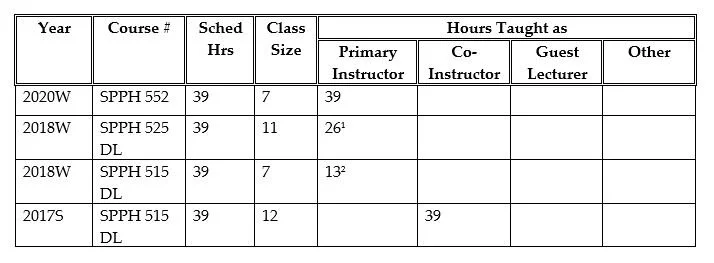Classroom Teaching
Courses Taught at UBC
SPPH 552: Risk and Communication in Public Health
Description: In SPPH 552, students are be introduced to the principles of science communication as well as the theory and practice of risk communication, specifically. The ultimate goal of the course is to provide students with the knowledge, practice, and mentorship required to develop and implement impactful risk messages for a variety of scenarios and applications. The course takes place within a blended learning environment utilizing a combination of asynchronous online and synchronous in-person learning.
Key Contributions:
Although this course had existed in the past, for the 2020F semester I developed a brand-new curriculum and designed the course for a blended learning environment (BLE) using the latest BLE theory and tools.
I developed an open-source course textbook entitled “The Mission, the Message, and the Medium: Science and Risk Communication in a Complex World.”
SPPH 525 DL: Issues and Concepts in Public Health
Description: This course is intended to expose students to key issues and concepts in population and public health. Students explore strategies, policies, and challenges by examining a variety of local, national, and international public health issues and topics. The course takes place within a blended learning environment utilizing a combination of asynchronous online and synchronous in-person learning.
Key Contributions:
For the 2018F semester, I developed synchronous, face-to-face modules on the intersection of public health and climate change, global health, program evaluation, and public health surveillance.
SPPH 515 DL: Surveillance and Monitoring in Public Health
Description: This course is intended to provide students with a strong foundation in public health surveillance of both infectious and non-infectious diseases. The course teaches the theory and practice of surveillance supported by examples of surveillance systems from Canada and other countries. The course takes place within a blended learning environment utilizing a combination of asynchronous online and synchronous in-person learning.
Key Contributions:
For the year 2017S semester, I developed synchronous, face-to-face modules on communicating surveillance information, ethics in public health surveillance, surveillance in low-resources settings, mental health surveillance, and surveillance for emerging public health threats. I also developed asynchronous, online modules on GIS and spatial surveillance, chronic disease surveillance, oral health surveillance, environmental health surveillance, injury surveillance, reproductive health surveillance, and overdose surveillance.
For the year 2018F, I developed new synchronous, face-to-face modules on principles of public health surveillance, evaluation of surveillance programs, and analyzing and interpreting public health surveillance data (the latter of which was developed in collaboration with Dr. Wei Zhang). I also developed a new final assignment where students were asked to design their own public health surveillance system based on the principles learned during the course.
Summary
1 I took over the final 2/3 of the course when the original instructor went on maternity leave.
2 Up until 2019 I taught in the DL stream focusing on SPPH 515 DL. This stream experienced declining enrolment culminating in 2018W, when my course was cancelled 1/3 of the way through. The entire DL stream was terminated in 2019, including SPPH 515 DL. I subsequently took over SPPH 552 and re-developed the course for delivery in 2020W.
Guest Lecturing
Example of a guest lecture for a UBC course:
A Journey into Systems Thinking
for SPPH 580 (OEH Capstone Course), 2020W
Example of a guest lecture for an external institution:
